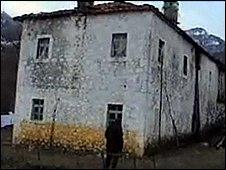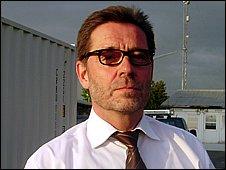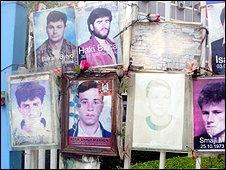End of the road for Kosovo organ claims?
- Published

Blood was found on the floor of the "yellow house"
For years rumours have circulated about Serbs abducted and killed for their organs in the months following the Kosovo war.
Three parallel international investigations, by war crimes investigators from Serbia, the European Union, and the Council of Europe, have failed to uncover any evidence that the Kosovo Liberation Army (KLA) trafficked the organs of captives, according to sources close to each investigation.
Dozens of predominantly Serb captives were allegedly taken to a "yellow house" near Burrel in central Albania from June 1999 to May 2000, where their organs were systematically removed and sold, according to accounts presented by Carla del Ponte, former war crimes prosecutor at The Hague Tribunal in her 2008 autobiography.
But the failure to find either the original sources, or any new evidence since 2004, may mean that the story was unfounded.
The Council of Europe report, due to be published next month by investigator Dick Marty, is expected to focus rather on political demands to the governments involved, rather than to uncover new facts.
Distraction
"The fact is that there is no evidence whatsoever in this case," said Matti Raatikainen, head of the war crimes unit of Eulex, the European Law and Justice Mission in Kosovo.

Matti Raatikainen says the scandal has distracted from the search for remains
"No bodies. No witnesses. All the reports and media attention to this issue have not been helpful to us. In fact they have not been helpful to anyone."
The main problem, he said, was that the scandal created by the allegations has distracted attention from the real work of finding the remains of 1,861 people still missing from the war and its aftermath, and prosecuting their killers - in Serbia, Kosovo and Albania.
We talked in his makeshift office in a cluster of containers at the Alpha-Bravo base near Pristina airport, as the latest May storm battered the roof.
Burly policemen came and went, surprised to find their boss talking to a journalist. Mr Raatikainen, a quiet Finnish policeman, is not known for his love of the media.
Loose ends
In 2009, a special BBC investigation found evidence of KLA detention camps in Albania, especially in the north-east Albanian town of Kukes. Earlier this month, Eulex made the first arrest in connection with that case.
Details have also emerged that Albanians suspected of disloyalty to the KLA were interrogated in a hotel in the Albanian coastal town of Durres, and transferred to Kukes.
But constant revelations in the Serbian press that new evidence, or new witnesses have emerged for the organ-trafficking allegations, have all proven either false, or unsubstantiated.
After the war in Kosovo, American journalist Michael Montgomery came across former KLA soldiers who said they had transported Serb and Albanian prisoners, dead and alive, across the border from Kosovo to Albania.
Three of his seven sources referred to the possibility of organ-trafficking, and identified the house near Burrel. But Montgomery was unsure, and handed a summary of his research over to the Office of Missing Persons and Forensics (OMPF) at the UN Mission in Kosovo.
Sources vanished
A team of UN and Hague Warcrimes Tribunal (ICTY) investigators, led by Matti Raatikainen, visited the house in February 2004.
A chemical spray, used in a downstairs room, found widespread traces of blood, of uncertain provenance, on the floor. Family members offered contradictory explanations.
Medical equipment appropriate for surgical interventions was found on the rubbish dump.
Some investigators wanted to pursue the case. Others felt the evidence, even then, was too thin.
Most serious of all, Montgomery's original sources had disappeared. One was dead, killed in a supposedly unrelated case. The others could not be found.
Even the Serbian authorities, who have propagated the tale of the yellow house most consistently, have their doubts today.
"I still believe something happened there," said a Belgrade source, close to the war crimes court, "but nothing on the scale of what has been suggested... and possibly not even connected to the KLA".
Mass graves
Considering the apparent lack of evidence, experts suggest the Albanian government could help kill off a damaging story if only it were more open.

Investigators are still searching for the remains of hundreds of victims
UN special rapporteur Philip Alston said in February that "none of the efforts to investigate have received meaningful co-operation on the side of the government of Albania".
"In order to get rid of this issue," he urged Albania, "make available a proposal for an independent investigation and offer genuine co-operation."
The end of the "fairy-tale" of organ-trafficking, as one Eulex prosecutor calls it, would still leave war crimes investigators with plenty to do.
This month, a mass grave was found near the southern Serbian town of Raska. Three lorry-loads of bodies - around 250 in total - believed to be Albanians killed by Serb forces in Kosovo, were reburied there in early June 1999.
The red soil encasing the bodies, according to eye-witnesses, suggests the bodies were originally buried in the Drenica valley in Kosovo, and moved to Serbia to destroy the evidence.
Prosecutors say they believe the Serbian military were responsible. Excavations at the same site two years ago failed to find the grave, which is now believed to lie beneath a car park and office building.
Revenge killings
Missing Serbs are also being found in Kosovo. The exhumation of up to 25 Serb victims of the KLA is due to start later this year in a coalmine in the town of Obilic/Obiliq. The coal was set on fire, and the mine shaft destroyed, to hide the evidence.
But the effort to find other victims is proving difficult.
"A lot of potential informants left," said Alan Robinson, joint head of the OMPF.
"Other persons, who may know the whereabouts of the missing, may not be willing to talk... out of fear, or lack of interest."
According to Eulex, 2,244 bodies have been identified in Kosovo since 2001. Of these 301 were "non-Albanian", meaning Serb, Roma and others.
Some 228 were the bodies of Serbs who went missing after 10 June 1999, the end of the war, at a time of revenge killings by Kosovan Albanians. In total, around 13,500 are now believed to have been killed during the conflict, or immediately after it.
Dick Marty's investigation for the Council of Europe into the organ-trafficking allegations is due to be published in late June. Exhumations at Raska will begin in August.